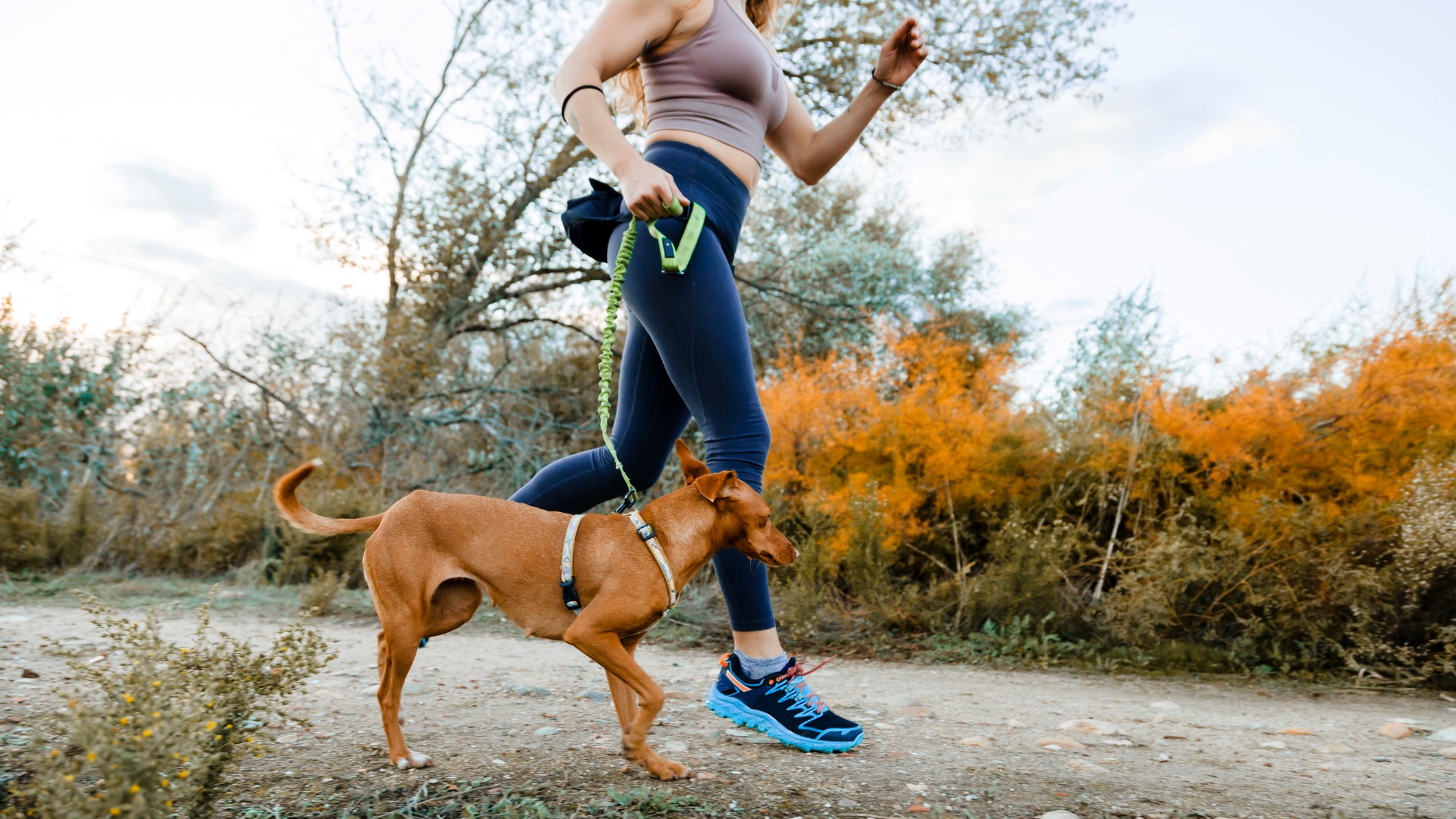How to run with your dog — here’s what you need to know
So you want to run with your pooch? Here’s how to do it.

So you want to start running with your dog, but you’re not sure where to start? Although it might sound like a great way to keep you and your four-legged friend fit, there are a few things to consider before lacing up your running shoes and heading out. Sure, your dog might bomb around the park, but if he’s not used to running on lead next to you, it’s important to consider how you’ll run together first.
To find out more, we spoke to Ian Scarrott, Running coach and personal trainer at PureGym, and Emma Lee, Nutrition Expert at Burns Pet Nutrition. Below, we’ve rounded up some top safety tips to read before heading out for a run with your dog.
1. Consider your dog’s breed
Despite what you might see at the dog park, not every dog is suited to sports. Lee advises that “caution must be taken with brachycephalic (flat-faced) breeds. These dogs often have problems with breathing and will struggle in the hotter weather as they are not able to cool down effectively. Being able to lose heat is also going to be an issue for some of the double-coated or heavier-coated breeds such as Siberian Huskies.
Also, some dogs, such as greyhounds, are sprinters, but aren't able to cope with long distances, other breeds that are very prone to orthopedic issues should also be treated with caution. Dachshunds for example are genetically prone to IVDD (disc disease) and a lot of larger breeds may be more predisposed to conditions such as hip dysplasia.
It goes without saying, it's a good idea to check with your vet before starting to run with your dog. It is not recommended to run with puppies, or dogs under the age of one, as they are still growing.
If you’re thinking about adding a pet to your family, according to the American Kennel Club, the best dog breeds to run with are Weimaraner, Dalmatian, Visla, German shorthaired pointer, Rhodesian ridgeback and English springer spaniel.
2. Think about both of your fitness levels
Not many people would jump straight in from 0 to 10K, so don’t expect your pet to do so either. If you do plan on recruiting your pet as a new running partner, you’ll need to build up their distance gradually. You’ll also need to think about the terrain, says Lee, “running is a high-impact sport so take care when running on firm ground. Also, be careful on uneven terrain. Dogs will be susceptible to similar types of skeletal and muscle injury that we are!”
Get instant access to breaking news, the hottest reviews, great deals and helpful tips.
Make sure you watch for signs of pain or discomfort in your dog, and ensure he or she has time to warm up and cool down before and after the run.
If you’re just starting out on your running journey and are finding your dog is actually the fitter one on the run, running coach Ian Scarrott suggests adding games into the run to keep your pet busy, but give yourself a breather. “For example, you could run to a park together and get some rest for yourself while keeping them active by playing a game of fetch” Scarrott advises.
3. Grab the right gear
Just like you might grab one of the best running phone holders, a pair of the best running sunglasses, or one of the best running watches before heading out the door, you’ll need to invest in the right kit for your pet to run comfortably too.
If you’re planning on running with your dog on a lead, a lot of experts recommend running with your dog on a harness rather than a collar, as the harness distributes pressure more evenly around the body, rather than on the dog’s neck. That said, you should do what is best for you and your dog, but ensure the harness or collar fits correctly and doesn’t restrict their breathing or cause them any discomfort. You want running together to be fun for your dog.
Scarrott advises running hands-free if you are running with your dog on a lead, “you may want to try hands-free running where you are connected by a secure waistbelt which means you are free to concentrate on the route, it also means your hands are free if you should take a tumble. It can help to avoid being pulled around uncomfortably, especially at speed”.

4. Fuel like a pro
Just like you might plan your meals around your run, you should do the same for your dog. Lee recommends feeding your dog “at least one hour before exercise, and ideally earlier than that to give them enough time to digest the food. We would recommend feeding two hours before and not feeding for two hours after. If you try to feed your dog too much, or too close to active exercise this can lead to the risk of issues such as bloating”.
It’s also a good idea to pack a collapsible water bowl or a dog-friendly drinking bottle for your dog when running together. “Hydration is important, particularly in warmer weather. A loss of just 7% of your dog’s body water can lead to severe dehydration and a 15% loss can be fatal. It is important to remember not to let them drink too much in one go however, make sure they rehydrate steadily rather than drinking too much, too fast”, says Lee.
5. Use it as a training opportunity
As well as being a way to keep fit, running together is a great way to bond with your pet, and work on their training. “It may be helpful in them learning new voice commands, meaning you are more in sync not only when running but also in everyday life”, Scarrott says.
6. Enjoy!
“Taking part in a sport with your dog can be beneficial for both you and your furry family member and should be encouraged more often. It helps to increase and maintain fitness and physical and mental health and can also strengthen your bond”, Lee adds.
Running with your pet can increase your motivation to head out the door, improve your bond, and keep you both fit, but more than anything else, you should both enjoy it, so be sure to take things slowly, and keep things fun.
Looking for more running guides and advice? Here have walk you through how to hide your address details on Strava, and answer 'can running give you abs?' and 'is running on a treadmill better than running outside?'. We've also found the best running apps to download, and the best Nike running shoes to invest in.

Jane McGuire is Tom's Guide's Fitness editor, which means she looks after everything fitness related - from running gear to yoga mats. An avid runner, Jane has tested and reviewed fitness products for the past five years, so knows what to look for when finding a good running watch or a pair of shorts with pockets big enough for your smartphone. When she's not pounding the pavements, you'll find Jane striding round the Surrey Hills, taking far too many photos of her puppy.
